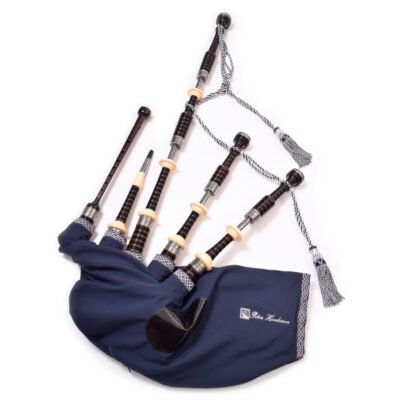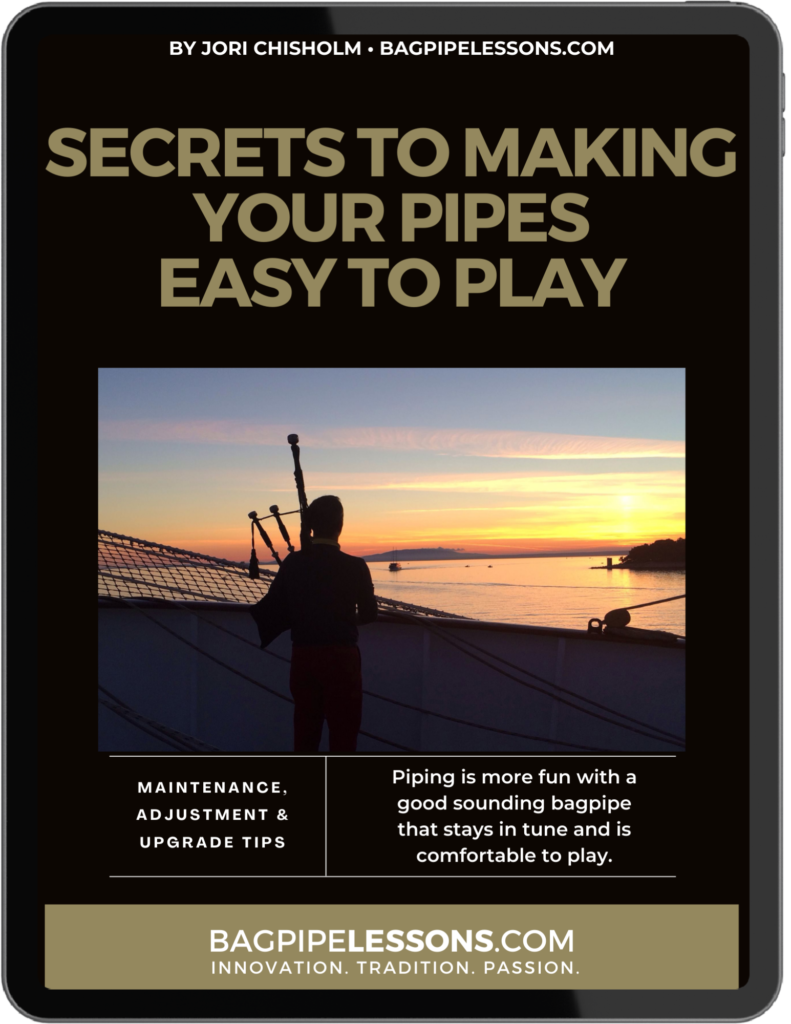
AS FEATURED IN

Unboxing the New Peter Henderson Bagpipes: Amazing Quality & Sound! New Model PH01 Review
by Jori Chisholm, Founder of BagpipeLessons.com
Last Updated: July 28, 2025
My new Peter Henderson PH01 bagpipes by R.G. Hardie have arrived, and I’m excited to unbox them and share my first impressions with you!
These pipes deliver exceptional craftsmanship, stunning visual details, and fantastic sound right out of the box.
I’ll walk you through every step—from the accessories included like the Bannatyne DriFlo moisture control system, Infinity chanter, and Deluxe Piper Case, to the intricate thistle engraving and modern enhancements like the plastic-lined blowpipe. Join me as I test the drones and chanter, explaining why these could be your ideal pipes for practice, competition, and performance.
Watch the video and scroll down to read the full video transcript.
The tune played at the end of this video is Banjo Breakdown.
Video Highlights
Factory Tour: I had the chance to tour the R.G. Hardie factory in Scotland on the day these pipes were released. Seeing the craftsmanship firsthand gave me a whole new appreciation for how much detail and care go into making these instruments.
New PH01 Set Highlights: This new PH01 set features a beautiful thistle engraving, African Blackwood construction, imitation ivory mounts, engraved nickel ferrules, and the Infinity Blackwood chanter. It’s a refined, high-quality setup that looks and feels premium right out of the box.
Moisture Control Systems: The Bannatyne Dri-Flo system and bottle trap work together to handle moisture perfectly. Warm, moist air helps the chanter reed, while the Dri-Flo ensures the drone reeds stay dry and happy—best of both worlds for tone and stability.
Modern Craftsmanship Meets Tradition: With CNC precision boring and laser-engraved details, these pipes blend the consistency of modern tech with the soul of traditional design. Each engraved nickel piece was handled one by one—seventeen pieces total!
Bag Cover & Aesthetics: The new Heritage bag cover and cords are sleek, UV-resistant, breathable, and in Scotland-inspired blue and white. The microfiber material feels great, and I love how well it holds up over time.
Initial Playtest: Out of the box, these pipes sound phenomenal. The Ezeedrone reeds locked in beautifully, and even with a brand-new chanter reed, everything felt efficient and steady. Just needed a few tweaks—some hemp, my rubber mouthpiece cover, and Perfect Angle Positioner.
Reflection on Modern Bagpipes: When I started piping, the best instruments were always vintage. Today, you can get something brand new—like this PH01 set—that rivals or exceeds the old masters in sound, build, and reliability. It’s an exciting time to be a piper.
Video Transcript: Hey everybody, Jori Chisholm here from BagpipeLessons.com. Thanks for tuning into the BagpipeLessons.com YouTube channel. I’ve got a new package here with some exciting new bagpipes, and I was going to open them up and show you what I got.
So what I have here is a set of the brand-new pipes from R.G. Hardie & Company. I was actually in Scotland just a couple of weeks ago and had a tour of the factory with my family on the day that these pipes were released to the world.
You may have seen the news article on Pipes|Drums. What they’ve done is streamline their offerings, really condensing it down to the very best of all the sets that they have. And Alistair Dunn of R.G. Hardie graciously sent me this set to have a look and to share with you guys. I’m really excited to see what they look like and hear what they sound like. This is sealed up. I have not opened these. So let’s take a look.
By the way, if you’re in Glasgow for piping or vacation or whatever, you should go to the R.G. Hardie factory. It’s really cool. I’ll probably be sending out an email or making some social media posts about my trip there and about my visit to the factory.
But for being one of the most prolific and famous and trusted bagpipe makers in the world, with this amazing historical tradition of Peter Henderson and R.G. Hardie, it’s not a very big place. It’s really neat to be literally in the room—or a couple of rooms—where they take pieces of African Blackwood and turn them into bagpipes, beautiful drones, Infinity pipe chanters.
It’s just really amazing. As a piper, you’re used to your instrument being how it is, trying to make the most out of it with your reeds and your playing. But what’s really cool is to see the raw materials and how these craftsmen transform them—whether it’s plastic made into pipes, chanters, and practice chanters, or the Blackwood.
Really, really cool. Alright, so this is what I got here on the delivery note. This is a set of Peter Henderson PH01 bagpipes with thistle engraving. Got my blowpipe length, Blackwood Infinity chanter with reed, Bannatyne hybrid pipe bag with the bottom zip, Bannatyne Dri-Flo moisture control system.
This is exactly my setup here: increased absorption Ezeedrone bass, standard tenors. And then they’ve got some new bag covers and cords, which I haven’t seen before. They’re calling these a Heritage line, so I got a navy blue Heritage bag cover with silver, and the Heritage navy drone cords. Piper case, deluxe piper case, and some other stuff. Cool. Alright, lots of bubble wrap.
This case looks nice. What do we have in here? Let’s open that in a second. And then we’ve got the pipe case here. Alright, let’s get rid of this.
Right off the bat, I can see this new style R.G. Hardie deluxe bagpipe case. Looks very cool. I have used one of these for a while and sold a lot of these to my students and customers. But this is new in that it has this silver braid on it. I like the silver. I think the previous model had gold. This is a great case. Plenty of room for all your gear. Soft case, but it has some stiffness to it.
Also in there, we have high-fidelity pipe and earplugs. Very good. Good to have earplugs. These are a good option. Looks like we got a golf towel. Very good for cleaning up all the various liquids and bodily fluids that are involved in piping.
Let’s open up these earplugs here—Pipe Down Plugs, quality hearing protection. Very good. So there you go. It’s got like a silicone flat-type earplug and then it’s got a filter.
What’s high fidelity about them is that this filter reduces the amount of volume coming into your ears, but it maintains the quality. These high-end musician’s earplugs have flat attenuation, so it takes all the sound and drops it the same amount so it doesn’t sound distorted.
It’s got a nice little case here. Plop those in there—cool. Keep that on your keychain or attach it to your pipe case or whatever. It’s got the little R.G. Hardie logo on it. Nifty. I like that.
Let’s put that aside for later. Okay, what was in here? Oh nice, so this is their maintenance kit. Very cool. Brushes—a skinny brush and a wide brush—for the stocks and the drones and the narrower part of the drones.
Bagpipe metal polish and sealant. Very cool. Polishing up the nickel mounts. And a little microfiber towel—this must be for the polish. Cool, shammy-type cloth. I’ll have to read and see what these are all for.
This is very cool. Oh, and Renaissance Wax. Oh, this is cool. I have some of this. This is for using on the wood to keep it all nice and polished. If you’ve seen or you play bagpipes that were made in the ‘50s, ‘60s, ‘70s, a lot of those bagpipes were shellacked.
They’d take the wood and, as the final step, put a shellac-like clear coat on it. That gives it a nice look, but the problem is that over time it gets dinged up and chips off and doesn’t look so nice anymore.
These days, bagpipe makers don’t use shellac. They use a wax finish. So that’s what this Renaissance Wax is about. I’ve seen this before—it’s sort of like a… well, take a look at it. Yep, like a hard wax that has a little bit of a shoe polish smell.
If you’ve ever polished up your shoes with wax in a can, similar to that—with no pigment though. So that is cool. Let’s take a look at the metal polish. It doesn’t say what’s in it. I’m not going to open this. It’s got a bunch of warnings on it: flammable, toxic, all that stuff. So put that aside.
Alright, very good. How about we get onto these bagpipes, shall we? Exciting moment.
Very good—some more literature. Practice chanters, maintenance options, registration card. This is cool. You can fill out your model number, serial number, stay in the loop. Very cool thing that they do.
Extra rocks for the Dri-Flo system. I love the Dri-Flo system. It’s a desiccant-based moisture control system for your drones. These silica gel beads are indicating, and they change color depending on whether they’re dry or wet.
When they’re brand new and dry, they’re orange. As moisture gets absorbed into the gels—they call them gels, but they’re hard, like glass or plastic beads—they eventually turn green. In between orange and green, they’re kind of a purplish color. That is very cool.
We got a little tube of lubricant for the zipper. Infinity pipe chanter, Blackwood. I’ll open that up in a second.
And here they are. This is how you want to do it if you’re ever shipping bagpipes. You want every piece to be individually bubble-wrapped. The reason is so they don’t bang against each other and get damaged.
The case has some stiffness and padding. That’s great. Then it’s in a cardboard box with more bubble wrap. But really, on the inside, you want to make sure that any jostling doesn’t cause chips. They’ve done a nice job here.
Very cool. So there is the blowpipe. That’s our first glimpse of the engraving. Really nice. I want my camera to not focus on my face… there you go. You can see that really nice thistle-style engraving. It’s a classic engraving pattern. I’ve never had a set of bagpipes with thistle engraving, but I really like it.
My first teacher, Colin McKenzie, had a beautiful set of silver and ivory bagpipes with that thistle pattern. I’ve always really liked that.
We got our flapper valve. This is Blackwood, so it maintains that traditional look to match the rest of the pipes.
But the moisture in your breath when you play one of these R.G. Hardie blowpipes never touches the wood. I actually saw this at the factory—how they make it. They call this the blowpipe; this is the mouthpiece.
The mouthpiece unscrews. This is replaceable. For example, if you needed a different length—longer or shorter—you could do that. This is plastic. And then down below, the part that’s hemped up that goes into the stock—that’s plastic as well. So it’s a plastic piece that goes inside the wood. That is really cool, because without that, this blowpipe would crack. And that happens a lot. It’s the most common part of bagpipes to crack—the blowpipe—because there’s just so much moisture going through there.
Alright, cool. Put that back in. Got a lot of bubble wrap here. Let’s start trimming this off carefully… Oh, there we go. That looks nice. Very nice.
While I’m doing this, I’ll just say that this is a really, really cool time to be a piper. Here we are in July of 2025. When I was starting out piping over 30 years ago, all the good sets of bagpipes were old pipes. And when I got to that point where I was looking for a really nice set—rising up through the amateur ranks and getting close to playing in the professional grade—I needed a really nice set.
We were looking for old pipes—pre–World War II, the golden age at that time. Pre–World War I Hendersons or Lawries or something like that. These days, you can get fantastic bagpipes that are brand new…
Wow, that looks really great. So this is a tenor drone. Got the thistle pattern here. I’ll give you a better close-up in a second once I get this thing totally unwrapped. That was the outside tenor.
You want to be careful when you’re cutting this bubble wrap—you do not cut the pipes, of course. There we go. So these days, you can get a fantastic set that’s brand new, and they’re going to be perfectly made.
Like I saw at the factory, these things are made by machine. Each piece is made individually. It’s not like they come off a big assembly line. Each piece is made individually by hand, but the boring is done by these computer-controlled machines, which is really amazing.
So you know it’s going to be perfect. And you also know that the design is going to be great because what these computer-controlled machines allow the pipe maker to do is test out different designs.
They can tweak a bore dimension here, make a bore wider or narrower, try different combinations of things. It allows them to do a lot more trial and error, and they can optimize and perfect their designs.
So you know you’re getting a really good design that’s going to be manufactured to perfection.
Alright, there we go. Oh, little label fell off. It says, “We recommend using Blackwood oil once a year and bagpipe metal polish and sealant every six months to protect your bagpipes.”
Alright, groovy. It was sort of held on there with a little rubber band. Okay, get rid of that. Getting close here, folks. This is the bass drone top, and finally, bottom section of the bass drone.
Okay, there we go. Beautiful. Nicely hemped up. The drone reed box is in here. Great. I think we are empty. Let me just put this aside.
Cool. So here we go. Very nice. From a distance, you can see this is the new Heritage-style bag cover. Very cool. It’s like a microfiber material. I play an older version of their bag cover that does have this material. It’s really nice. A little bit stretchy, synthetic, breathable microfiber.
On the inside—also very cool—it’s got the zipper, and then it has a little bit of fleece. You know, it’s a little bit fleecy, which is nice. So it’s breathable.
We have our Bannatyne small bag with the bottom zipper. Great. And here are the Dri-Flo cartridges. You can see what the Dri-Flo looks like. There are three of those—one for each drone. Little air holes here and on this end. Small enough to let the air pass through but the silica gel doesn’t fall out.
This goes with a little rubber cup and a tube that goes to the bottom of each drone stock. This is sealed to the bottom of the drone stock, so there’s no way for any air to get to that drone reed and out that drone unless it passes through one of these.
So you fill up the bag, increase the air pressure, and the air travels through the tube. As it travels through, these silica gels remove the moisture from the air. So it’s warm and moist air in the bag, and as it travels through, the moisture is removed. By the time it gets to the drone reed, it’s warm and dry—which is great.
So there’s three of these. Love my Dri-Flo.
It also has the Bannatyne bottle trap. So this is a tube that’s connected to the blowpipe. I blow into this, and it’s the first line of defense. Any spit or drool and some condensation gets caught in the tube. Anything that gets to the end of the tube sprays out into this bottle. This bottle has holes in it. It’s not designed to seal anything, but it’s a physical way to catch any spit or condensation that gets to the end of the tube.
And then this chamois in here—just an absorbent chamois cloth—it absorbs some of the condensed water. After I play for, you know, half an hour or whatever, this tube’s going to be filled with all kinds of droplets of water, and this little chamois cloth in there will be wet as well.
So what that does is filter out some of the moisture, but still, the bag is going to be very hot and steamy. And we want it that way. We want the air inside the bag to be warm and moist, because that chanter reed in our Infinity pipe chanter is a cane reed—so it wants moisture.
Whereas the drone reeds—they’re synthetic—so they want to be totally dry. That’s why we have two levels of moisture control. The tube with the bottle and chamois—that’s attached to the blowpipe I blow through—that takes out some water.
But then we have the Dri-Flo with the silica gel—that filters out any remaining moisture before it gets to the drone reeds.
Just got to get that back in there. Very cool.
And the little tube of zipper lubricant—you don’t need this to keep the zipper airtight. The zipper is air- and water-tight on its own. But what the lubricant does is—you just put a little tiny dollop, maybe the size of a pea—and it lets you open and close the zipper more easily. So it’s less wear and tear on the zipper. You don’t have to pull so hard.
So it’s not about sealing—it’s just about keeping that zipper nice and easy to open and close.
Alright, now we get our bag cover zipped up. Got the velcro on the back—nice seal there. Cool.
You see different types of bag covers in terms of material. I used to see tartan or velvet, velveteen, or corduroy. But I like this smooth synthetic material. It holds its color really well.
If you use a standard fabric that’s not designed for outdoors or for intense UV, it will tend to fade. I’ve had bag covers fade. Sometimes you see pipe bands playing and they have various versions of the same color of bag cover—because some are older.
This type of fabric does a really good job with sweat, moisture, and dealing with UV from being out in the sun.
Cool. So there we have it. African Blackwood bagpipes with imitation ivory mounts.
A hundred years ago, these would be real elephant ivory, but we don’t do that anymore. We don’t want to be involved in killing elephants to make bagpipes, because it’s just decorative. And the imitation ivory looks really, really great.
And then we have the engraved nickel. Now that’s really cool—check that out. So neat. See that thistle pattern? Also on the ferrules. It’s a beaded and capped ferrule. So you can see that little bump here—they call that a bead.
Capped means that the metal goes on the underside. Sometimes you’ll see ferrules that are just a tube of metal—they don’t have the bead or underside—but this is beaded and capped.
You can see on the drone cap—it’s also beaded. Engraved on the top, but also engraved on the side. Really nice.
This is the bushing, which is also imitation ivory. Then you can see the slides. Really, really nice.
Somewhere on here it says Peter Henderson… There it is—on the top drone slide on the bass drone. You can see there: Peter Henderson. Really, really cool.
So you know as a piper, you mostly care, number one, about how your pipes sound. But you also care how they look.
And it’s really interesting to learn how these pipes are made. These new pipes that they’ve just released—these three styles of engraving—are all done by laser, and it’s really, really cool. I think they still have their very, very top-of-the-line bagpipes with silver.
You can get them with silver if you want to spend many, many more thousands of dollars having silver on your bagpipes. It doesn’t affect the sound at all. Some people really want the fanciest, most expensive thing.
So you can get silver, and you can get silver that’s been hand-engraved. But what you have here is this laser-engraved pattern, and it’s just so cool.
We were actually at the factory with my family, watching them use this machine. Each piece is loaded into the engraver one at a time.
This set of bagpipes has—let me count—one, two, three… seventeen pieces of nickel that were all engraved one at a time by the machine.
Alistair Dunn was telling me that this new machine has a more powerful laser and is able to really etch it quite deep, so you can really feel the depth of the engraving.
What’s cool about this is it has a vintage look. The way the engraving works is you’ve got the shiny parts of the silver or nickel, and the etched parts already have this cool kind of patina to them.
They also have a new mount shape. People who are really into bagpipes and vintage bagpipes can spot a set based on what the mounts look like.
Very cool.
Let’s see what we got for drone reeds in here… nope, no drone reeds yet. Let’s pop a tenor in. Beautiful. Love that double tone—first tone, and then it kicks into a second tone. Beautiful.
That joint is a little bit loose, even though I’m sure these were perfect at the factory. What happens with a new set of pipes—any time you re-hemp a joint—the hemp will pack down with time. Just a little bit of dental floss on here. As it packs down, it’ll get loose, and you just have to add a couple more layers, and then you’re good to go.
And here’s the bass reed… hopefully? No bass reed. Alright, maybe it didn’t fall into the bag. But I do have other bass reeds over here, so let’s grab one. Here’s an Ezeedrone bass I can pop in there.
So the progression for pipers is: when you first start out, you get your set of bagpipes and all your gear fits in your pipe case. Then you have old things and new things and extra things and backup things. Then maybe you have a little bag, or maybe you have a drawer. Then you have a whole bunch of drawers. Then you have a whole room. That’s where I am. I’m in the more than a whole-room-full-of-bagpipe-stuff phase of life.
Okay, let’s add a little bit on here. Beautiful. You can hear that really nice double tone—beautiful—and it goes thunk when it goes into that second tone. That means that drone and that reed are happy together. Everything is operating as it should be.
If you have a tenor drone or a bass drone that makes a single tone—not a good sign. Okay, let’s check this out.
Beautiful. So easy. They’re hardly taking any air. Smooth. They lock in tone. This is—I’m not surprised—but this is exactly what you want. Fantastic.
Last thing to try is the Infinity Chanter. Now… there it is. Beautiful. Leather case. Infinity Chanter. This is the world’s best Blackwood chanter, in my opinion. Amazing sound. Amazing feel. The holes are smoothed out.
You can see that there. But I’ve done a whole bunch of other videos about the Infinity Chanter on this channel. Not only are the holes smaller than a lot of other chanters and closer together, but the edges are sanded. It gives it a really, really nice feel.
Now, this is not a Tone Protector. This reed is going to be really dry. Yeah, it’s dry. So what I’m going to need to do is get a Tone Protector on it.
And what that’s going to do is that’s going to acclimatize the reed. I’m not going to do anything to that reed right now until it’s had a chance to get acclimatized to the right humidity.
This is my chanter that I’m playing currently. Wow—and it fits. Amazing. Perfect. Let’s see how this sounds.
Wow, amazing. So this is my chanter—never been played with these pipes before. Really, really amazing out of the box.
A couple of things I’m going to need to do to get these just right for me: I’m going to put a rubber mouthpiece protector here, because I don’t like to bite on that hard plastic.
And the other thing—I’m going to get my Perfect Angle Blowpipe Positioner, which I always play with. Without it, the blowpipe wants to pop out, so it’s not so comfortable on the teeth for me. So I want to get the rubber, and then get the Perfect Angle.
What that does—it’s a system that attaches to your blowpipe and your two drone stocks, goes underneath the pipe bag so no one sees it, and it just holds your blowpipe in the right position so it doesn’t want to pop out.
So I’m going to need to adjust those and probably add a little bit of hemp, just to make sure everything is exactly as tight as I want it to be.
But holy cow—these pipes sound great. They look great. They feel great to play. They’re really efficient and steady. And they’re just going to get better as these drone reeds get played in a little bit and as I get used to them.
So really, really cool. This is what I expect from R.G. Hardie. R.G. Hardie, Peter Henderson—they’re the same company.
What we’re looking at here—let me get the number right—this is the new PH01. So this new line was just released in July 2025. And here we are, just a couple weeks later. Amazing beading and combing. High-quality Blackwood.
I also love—every time I get a new set of bagpipes or a Blackwood chanter—I take photos of it. So I’m going to go outside with some sunlight and get some nice up-close pictures of these pipes. Because this beautiful wood grain will disappear.
The grain and the striping in the grain that you can see now will all fade to black with time. With oxidation, with oils from my hands, just from aging—it will go jet black. And it’s always fun to look back and go, “Wow, my pipes used to be a lot lighter, different color.” But it’s also really cool when they turn that jet black color.
So there they are. Got the new Heritage cords with blue and white. If you know me, I love blue. Half my YouTube videos, I’m wearing a blue polo shirt. So blue and white—Scotland colors.
The Heritage bag cover with the Celtic knot design ribbon. The amazing plastic-lined blowpipe. Also, the blowpipe stock—you can’t see—that’s also plastic-lined. Wood on the outside, plastic on the inside. So that will never crack.
Then tomorrow or the day after, I’ll check on my Blackwood Infinity Chanter with the new reed—see how that’s going.
If you are interested in these, check them out in my shop. I’m going to get these up on the shop as soon as I can. Go to BagpipeLessons.com/hardiepipes — H-A-R-D-I-E pipes. That will take you to the plastic Hardie pipes that I have, and also the Peter Henderson pipes that I’m going to get on the shop very soon.
But these are beautiful. They sound good. They look good. Gosh, they’re fun to play. I want to play some more.
Thanks for tuning in. And if you’re interested in watching more of my videos, click Subscribe to join my BagpipeLessons.com YouTube channel, and click the little bell so you get notified.
If you’re interested in learning from me, consider joining my BagpipeLessons.com Inner Circle. I do weekly live classes on Zoom almost every week. And you also get access to all of the live classes I’ve ever done.
We’re talking about hundreds of them. They’re all recorded for you to watch on replay. So you can forget Netflix, forget Disney+, Hulu—join your BagpipeLessons.com Inner Circle and you have hundreds of hours of binge watching.
It’s all bagpipe-related—and also hundreds of other lessons, PDFs, exercises, tunes, product guides, and reviews. And you also get feedback from me. Every month or so, we do a member video session where you can submit videos of your playing and I’ll watch it and give you some individualized feedback.
You can learn more about my Inner Circle at BagpipeLessons.com/membership.
And also, if you’re looking for Tone Protectors, Pokers, the InTune Mic, the Bagpipe Gauge, my Foundation Reed, my exclusive Ezeedrone set—those are all available at the shop at BagpipeLessons.com/shop.
Thank you so much for watching, thanks for listening, and for enjoying this new set of bagpipes with me. And thanks to Alistair Dunn at R.G. Hardie for these beautiful new pipes.
I’m going to play some more now. Thanks for watching!
My first bagpipe teacher, he played without a valve. So he’d blow and then he would cork the stopper—the end of the blowpipe—with his tongue. I just think that’s crazy. I mean, maybe they got used to it and the old-timers would do that, but it’s so much easier now.
Really good, super tight seal. And what I love about having the valve inside is that when you’re done playing—this gets a lot of spit on it or water or condensation—you can just take this out, toss it in your pipe case, and things will air out better. The valve is not in danger of getting damaged. That is a really cool thing.
Just take a close-up look here—I mean, this is just amazing. There we go—focus on that. It’s just really amazing quality work. Beautiful, beautiful work.
So you have the amazing design expertise from R.G. Hardie—the great history with that company. And Alistair Dunn, who’s the director there—I’ve known him and worked with him for a long time. Alistair’s a perfectionist. And so you just know that anything that comes out of their factory is going to be really, really perfect—not only in terms of the materials and the manufacturing and the craftsmanship, but the design as well.
He is one of the world’s top bagpipers and won all the awards in solo and band and gold medals and everything. So you know it’s going to be great.
So what do I love about these bagpipes? Beautiful manufacturing—they really look perfect. They have that traditional look even though they’re this plastic material. I’ve always called it poly. I think they call it acetyl—it’s the same basic idea. Different names for it. You might have heard of the words Delrin, Delrin, Polypenco, Poly, Acetyl, Acetyl Resin. They’re all very slight differences—different words for basically the same thing, which is this extremely hard, beautiful, shiny plastic that we make practice chanters out of, and mouthpieces, and pipe chanters. If you have a plastic pipe chanter, that’s what it’s made out of. And now we’ve been making drones out of these for a while as well.
So—great manufacturing, great design, really resilient and tough. You’re not going to have any issues with the elements with these bagpipes.
I have some very fancy, very expensive blackwood sets with silver and engraving and all kinds of fancy stuff on them. And I love playing those. But I love playing my R.G. Hardie plastic bagpipes.
When do I use them? Well, anytime I’m going to be in extreme weather conditions, or in a place where I think my pipes might take a little bit of a beating. So if I’m playing in a parade and it’s going to get rainy and it’s cold, I’m definitely taking my plastic pipes. If I’m playing in a pub and it might be crowded and a lot of people and a lot of excitement and fun—like St. Patrick’s Day—but I might be leaving my pipes somewhere on a table or get a beer spilled on them or something—I’m taking my plastic pipes.
I also take these when I’m traveling—not for competition—but if I’m traveling somewhere, when I go hiking or backpacking or camping or boating—I definitely take these because I don’t want to take my wood pipes. I would be very, very bummed if they got stolen. But I would be more bummed if my blackwood bagpipes with all the fancy silver engraving got stolen. So I’m a little bit less paranoid when I take my plastic pipes, because I know I can just call up R.G. Hardie and order a new set.
Prices are changing, just because—with the exchange rate and also various things going on with tariffs and various duties and all that stuff—check the website for the latest pricing. But it’s a great, great deal.
If you want to put your pipes together yourself, you can get the “sticks only,” and then you can pick your own pipe bag and cords and drone reeds and pipe chanter and do that whole thing yourself. Or I can put it together for you. So you can order just the sticks, you can order set up with the basics, or you can get the whole set up with everything—with all my Tone Protectors and reed case and all my other accessories and gadgets too.
So these are an amazing set of pipes.
If you’re looking for a beginner set and you’re just getting started out and you want something that’s really quality at a price that’s going to be friendly to your wallet—this is the way to go.
If you have a set and you’re looking for a second set—again, these are not a cheap set of pipes—these are a really, really quality, quality set of pipes. I would have no problem performing with these or competing with these bagpipes. These are amazing and they’re at a great price.
It has never been a better time in history to be a bagpiper, right now, for a lot of reasons. But one of them is really high-quality instruments that are available at a great, great price.
One of the problems for people trying to sell a used set—maybe you’ve got a set you’ve been trying to sell—it’s hard to sell a used set these days because you can get a new set that is so great for a really good price. But that’s the benefit to anybody who’s looking to buy a set of pipes.
So check them out—the R.G. Hardie P01 Acetyl Bagpipes. You’re going to love them. Check them out—BagpipeLessons.com.
Thanks, everybody. If you have an idea for a video—whether it’s a product video or a tune or something you’re working on, a piece of gadgetry or equipment—shoot me a note, put it in the comments below, send me an email, go to BagpipeLessons.com, join my email list, and I’ll send you some really cool, helpful stuff that will help you with your piping.
Thanks, everybody. See you next time. Mahalo.





